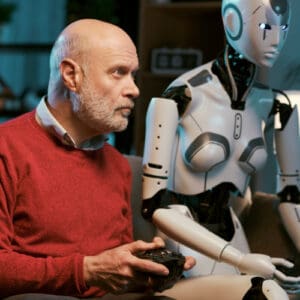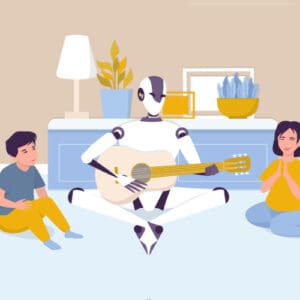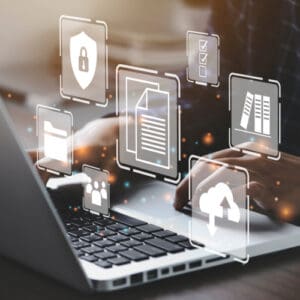
AI / IoT / Robotics in Healthcare
Embracing High-Tech Innovations to Revolutionize HealthcareDelivery and Exceed Regulatory Directives

Optimize Operations / Customize Care The rapid advancements of 21’st Century technology continue to herald diverse and positive changes for the healthcare industry, especially for its earlier adopters. Effective bundling of such technologies allows users to make informed decisions, optimize operations, and customize care as never before.
Pushing Boundaries CHN’s commitment to harnessing Healthcare AI, VR, IoT and Robotics echoes the Company’s dedication to pushing the boundaries of what’s possible, ultimately paving the way for a more efficient, precise, and person-centric healthcare journey.
CHN/CCS Axis AI and IoT functionalities and interfaces will be central to CHN system deployment, maintenance, and continuous advancements. All operations and services will be incorporated and cross-referencing.
Universal Informatics This cloud-based and customized IT/IS system will be the axis of Conscious Health Network. All healthcare informatics will be digitized, collated, organized to task/silo-enabled, and available through the numerous access points of this multi-faceted and all-encompassing core.
Goals include improved communications and throughput for:
- 1) protocol implementation initiatives
- 2) delivery of intuitive/web-based software systems to clients
- 3) streamlined and automated documentation
- 4) maximized "hands on" caregiver time
- 5) expanded JIT training, feedback, & tracking
Can Robots Save Nursing Homes? The pandemic has given a new urgency to the development of robots and ‘virtual assisted living’ that can help care for aging adults, physically and emotionally.” https://www.nytimes.com/2022/04/21/realestate/nursing-home-robots.html
CHN / CCS / I-WELL Robots and robotics are increasingly being embraced in the long-term services & supports / LTSS market; however, the industry is, per usual, still way behind the times. The U.S. is particularly lagging relative to other industrialized countries such as India, Japan, China, and certain EU members. Robots have many and varied functionalities and price points and come in numerous forms.

Next Gen LTSS Absolutely essential to NextGen LTSS is reducing costs and improving care and quality-of-life as is obvious to all. CHN contends that these requisites can best (and perhaps only) be met with judicious and standardized use of robots and robotic technologies.
“I’m Just an Aide” – no more! Many of the most onerous, boring, or time-consuming tasks, especially for direct service personnel, may be performed by or with robotic assistance. No longer will personal care staff be relegated to assignments that are not only unpleasant, but often confer low status to these individuals, despite frequent lip service to the contrary.
High Turnover Rates In addition, specific CHN/CCS protocols, including the use of robots, also factor in resolving an important issue in care delivery which is extremely high turnover rates for Certified Nursing Assistants/CNAs, and other paraprofessionals, as well as RNs and LPNs further stressing the foundering LTC industry. Even highly compensated Administrators and Directors of Nursing (DONs) have very high turnover rates, however reliable annual percentage estimates for all LTC positions vary considerably depending on documenting sources.
Different Strokes There are varied utilitarian robots; some are autonomous and can easily maneuver on different terrains and negotiate building layouts with differing mechanical conveyances, while others in fact ambulate. Some of these machines are “virtual” and others are physical assistants to workers in virtually every department.
Virtual Friends In addition, and importantly, there are many robots, large and small, with a variety of abilities, that offer numerous services to clients and residents with physical and/or cognitive impairment. From medical, rehab, therapeutic, etc., capabilities to life enrichment services (per each meticulously considered goal plan), these handsome and seemingly loving, “virtual friends”, will become valued companions that (who?) provide a lifeline and touchstone to each person, and “who” will become intrinsic to their happiness – and health.
Engaging & Caring Robotic companion services may include such offerings as individualized and comforting conversation, playing evocative and preferred music, and streaming cognitively appropriate videos, audiobooks, family recordings (e.g., of grandchildren, friends, clergy, life coach), per CCS implementation models.
CHN Technology Requirements
-
- Integrated Multi-function Portal specially designed for ease-of-use with
- Graphic User Interface (GUI) especially for low computer literacy
- Adaptable Look & Feel (GUI) for multi output device configuration (computers, tablets, phones)
- Modular & Customizable Functions to optimize function, look, and feel
- Announcements Modules, Calendar, Email, News
- Touch-screen Ready Module used to build touch screen applications
- User Friendly / Accessible – Platforms designed to support staff, volunteers, families, and community members, as well as residents / clients, regardless of cognitive levels and physical abilities
- Portal Leverages Wireless Internet connection services for varied client interfaces, e.g., Enriched Lifestyle programs and services
- Centralized Hub to “Host” Integrated Functions & Database
- Portals Communicate to hub
- Hosts Back-end functions
- Curates User Security (by role, business function, position)
- Applications for Intergenerational and Elder Living communities
- Integrated with Multi-media portal functions
- Regulatory Module (Compliance, QA)
- News – facility/community-based, regional, national
- Multi-media modules for training distribution for all levels within defined categories and secured by user role and responsibility.
- Just-in-Time (JIT) and Enterprise Training and Learning
- Internet and Intranet Training and Applications
- Interactive & Streaming Video, VR, AI, etc.
- Touch-Screen Training User friendly, Reward-based, Easy to Understand
- Web-based Textual Medium
- “Push” Technology to announce & distribute programs/training
- Database structure to support governmental requirements of MDS / RAI (Minimum Data Set/Resident Assessment Instrument) for Skilled Nursing Facilities/SNFs, and OASIS (Outcome Assessment & Information Set) for Homecare Agencies, and Hospice.These databases are used across all individual roles to ensure the capture, tracking and reporting for the Centers for Medicare & Medicaid / CMS.
CMS audits SNFs, Homecare, and Hospice, which includes assessing the mental and cognitive status of residents and their activities, in order to determine regulatory compliance and reimbursement.
(Similar documentation is sometimes used [not mandated] by other LTC communities, e.g., Assisted & Independent Congregate Living, Adult Day Services, CCRCs).
- The CHN / CCS Compliance modules improve and further standardize MDS / RAI and OASIS reporting and analysis. These applications may become the de facto industry standards for MDS / RAI and OASIS.
- An existing MDS / RAI documentation system (already chosen from an LTSS software company) will be combined with the CHN Platform which is designed to dovetail with the MDS / RAI.
- Interactive web-based CHN / CCS applications to capture and manage MDS / RAI information and its flow. Interfaces will be derived by designing an integrated, universal data structure corresponding with the MDS / RAI & OASIS Assessment documents.
- Employee accommodations establish and support each staff member securely within their role/responsibility re LTSS function. Each user only interacts with those portions of MDS / RAI or OASIS applicable to job description and task at hand.
- Additional Reporting tool for MDS / RAI & OASIS at the LTSS department/function level
- Cutting-edge Document Management System for versioning, archiving and storing of documents electronically and securely
- Data Integration Interface, e.g., XML, HTML, etc. for local, regional and national data flow, including MDS / RAI & OASIS
- CHN Marketing & social media modules to be used by LTSS clients for promotion and information campaigns.
CHN client websites to promote the facility / community to prospective clients, and to tout CHN.

- Integrated Multi-function Portal specially designed for ease-of-use with
Links: AI / IoT / Robotics – Advanced Healthcare Technologies
Robotics in Healthcare
Robotics & AI
Eldercare Robotics, etc.
https://www.eldersuite.com/ (Adult Day Services)
Reviews
Artificial Intelligence / AI in Healthcare
Elder Abuse and Neglect Identification
Introduction to Becoming an Elder AI Hero.
Services & Eligibility, etc.
Become an Elder AI Hero: Harnessing the Power of Artificial Intelligence By Mark /5 23
Artificial Intelligence (AI) is exploding! And it’s everywhere. It is revolutionizing the way we live our lives. All of us, even Elders* can benefit from diving into the future that is now. From virtual assistants to self-driving cars, AI is changing the way we interact with technology. But what does this mean for Elders? In this blog post, we’ll explore how AI can help Elders become more effective and powerful in their daily lives.

An Elder AI Hero is an Elder, of any age, who embraces the power of AI to improve their own daily life and the people around them. By learning about and using AI technology, Elders can become more independent, connected, and empowered. Whether it’s using a virtual assistant to set reminders or a smart home device to automate tasks, there are countless ways that AI can help Elders live their best lives.
So why would you want to become an Elder AI Hero? The answer is simple: because AI has the potential to improve the quality of your life. By harnessing the power of technology, you can stay connected with loved ones, maintain your independence, and even improve your health. Becoming an Elder AI Hero means taking control of your life and embracing the future with open arms.
What is AI? –
AI refers to the development of computer systems that can perform tasks that would normally require human intelligence, such as understanding language, recognizing patterns, and making decisions. These systems use algorithms and machine learning to improve their performance over time.
Why is AI important for Elders? – AI has the potential to improve the lives of Elders in several ways. Here are just a few examples:
- Virtual assistants like Siri or Alexa can help Elders with tasks such as setting reminders, making phone calls, or finding information online.
- Smart home technology can help Elders live independently for longer by automating tasks such as turning off lights or adjusting the thermostat.
- Health monitoring devices can use AI to track vital signs and alert caregivers or medical professionals if something is wrong.
How can Elders get started with AI? – There are many free AI tools available that can help Elder AI Heroes improve their lives. Here are just a few examples:
Virtual Assistants: These tools can be used to set reminders, make phone calls, send messages, and even control smart home devices. By using a virtual assistant, Elders can stay organized and connected without having to remember everything on their own.
Language Translation: AI-powered language translation tools like Google Translate can help Elders communicate with people who speak different languages. This can be especially useful for Elders who have family members or caregivers who speak a different language. By using a translation tool, Elders can overcome language barriers and stay connected with the people they care about.
Health Monitoring: There are many free health monitoring apps available that use AI to track vital signs and alert caregivers or medical professionals if something is wrong. Apps like Apple Health and Google Fit can track things like heart rate, blood pressure, and sleep patterns. By using a health monitoring app, Elders can stay on top of their health and catch potential issues before they become serious problems.
Conclusion – Learning to use AI effectively has the potential to improve your life in ways you may not imagine. It can help you live independently, stay healthy, and stay connected with those you love. By taking advantage of the free AI tools available and learning how to use them, you can become an Elder AI Hero. You can harness the power of AI technology to improve your life.
Artificial Intelligence/ AI & Nursing 4’20 / Nursing/Nursing Informatics
ARTIFICIAL INTELLIGENCE (AI) is evolving and will transform healthcare. Given the potential of this technology for patient care and its impact on clinical providers, it is essential for nurses to have a basic understanding of AI concepts. This article examines the technology and the role of nurses in incorporating it into the healthcare setting.
Nothing artificial about evolving nursing intelligence Nurses have always been uniquely positioned to influence how technology is synthesized at the point of care. A new set of skills and practical knowledge is needed to interact with machines as an additional contributor to the care team.
AI technology is emerging as a partner with nursing to rapidly synthesize information, complete work, assist with clinical decisions and improve patient outcomes. Individually, each of these emerging technologies offers tremendous opportunity to improve care. Combining these solutions and educating nurses on how to best interact with machines will open unlimited solutions for efficiency, capacity, quality and healthcare transformation in the future.
Artificial intelligence (AI) comprises many healthcare technologies transforming nurses’ roles and enhancing patient care. In healthcare, AI typically refers to the ability of computers to independently convert data into knowledge to guide decisions or autonomous actions. However, precisely defining AI can be challenging because of its breadth of applications, including risk prediction algorithms, robots, and speech recognition—all of which augment nursing practice and are on a fast track to changing healthcare as a whole.
Nursing AI tools include clinical decision support, mobile health and sensor-based technologies, and voice assistants and robotics. (For an introduction to AI, including definitions of machine learning, deep learning, and other related terms, visit myamericannurse.com/how-artificial-intelligence-is-transforming-the-future-of-nursing.)
IoT – Internet of Things
The Internet of Things: Impact and Implications for Health Care Delivery
Abstract The Internet of Things (IoT) is a system of wireless, interrelated, and connected digital devices that can collect, send, and store data over a network without requiring human-to-human or human-to-computer interaction. The IoT promises many benefits to streamlining and enhancing health care delivery to proactively predict health issues and diagnose, treat, and monitor patients both in and out of the hospital.
Worldwide, government leaders and decision makers are implementing policies to deliver health care services using technology and more so in response to the novel COVID-19 pandemic. It is now becoming increasingly important to understand how established and emerging IoT technologies can support health systems to deliver safe and effective care. The aim of this viewpoint paper is to provide an overview of the current IoT technology in health care, outline how IoT devices are improving health service delivery, and outline how IoT technology can affect and disrupt global health care in the next decade.
The potential of IoT-based health care is expanded upon to theorize how IoT can improve the accessibility of preventative public health services and transition our current secondary and tertiary health care to be a more proactive, continuous, and coordinated system. Finally, this paper will deal with the potential issues that IoT-based health care generates, barriers to market adoption from health care professionals and patients alike, confidence and acceptability, privacy and security, interoperability, standardization and remuneration, data storage, and control and ownership. Corresponding enablers of IoT in current health care will rely on policy support, cybersecurity-focused guidelines, careful strategic planning, and transparent policies within health care organizations. IoT-based health care has great potential to improve the efficiency of the health system and improve population health.
Benefits of Internet of Things (IoT) in Healthcare
The use of IoT technologies in healthcare offers great opportunities. For example, more effective and more accessible telemedicine, remote conditioning and treatment monitoring, control over medical adherence.
The healthcare industry is one of the most important industries in the world, but it takes a long time for innovations to adapt to this industry due to complexity, level of responsibility and tight constraints. However, many things have changed as the pandemic process has revealed the vulnerabilities and ineffectiveness in the health industry. The Internet of Things could be the technology that can help us solve these and similar problems in the healthcare industry.
The use of IoT technologies in healthcare offers great opportunities. For example, more effective and more accessible telemedicine, remote conditioning and treatment monitoring, control over medical adherence. However, IoT applications are advancing at a very slow pace in healthcare.
What Is IoT in Healthcare?
More than 60 percent of healthcare organizations worldwide are either implementing or researching IoT solutions in healthcare. The number of patients and professionals in healthcare using IoT-connected devices for health monitoring is expected to increase significantly in the coming years. The Internet of Things may be a solution to certain problems experienced in healthcare over the years. For example, low medication adherence rate, lack of tools for treatment control, patient monitoring and shortage of skilled professionals.
The Future of IoT Technology in Healthcare
IoT applications in healthcare and medicine are numerous and cover a wide array of technologies, from futuristic robots and drones to ML-based data analytics. With the increase in demand for mobile telemedicine tools and remote patient monitoring technologies during the pandemic period, governments and investors have also realized that the role of IoT in healthcare services has increased. For example, drones are used to deliver drugs to patients whose treatment is done at home. In Rwanda, donated blood is transported by drones.
Essential Benefits of IoT in Healthcare
- IoT enhances the capabilities of preventive medicine
- Increased mobility and alert of hospital staff
- Accelerated processing of patient data
- Better management of drugs and medicine adherence
- Reduced risk of error and miscalculation due to the human factor
eBook: A Guide to Windows IoT for Healthcare Applications
This eBook provides a comprehensive overview of the features and capabilities available in Microsoft operating systems for healthcare applications.
The ability to digitize, collect, aggregate, and utilize data is opening up a new data-driven business, operational, and clinical model shaping the future of healthcare. The opportunity to deliver high-quality outcomes for patients and business efficiency for healthcare providers using digital transformation (DX) has never been greater. Healthcare providers who direct new investments towards technology that dramatically improves patient results, safeguards privacy, and utilizes data to provide personalized care are likely to be highly successful.
Operating systems play a vital role in ensuring performance, stability, and security of healthcare devices and appliances. Microsoft’s device-to-cloud platform approach has been designed to meet the strict device requirements for medical applications. The Windows IoT operating system with Azure IoT offers an ideal foundation with long life, advanced safety and locking mechanisms, enhanced security, and scalability.
Connect with Us!
Please feel free to contact us for additional information